(PDF) Financial Performance Analysis Assignment
Added on 2021-02-20
15 Pages3450 Words1530 Views
Finance.

Table of ContentsINTRODUCTION...........................................................................................................................3TASK...............................................................................................................................................32.1 Analysis of financial performance of Tesco compared to its competitor Morrisons:..........32.2 Company Valuation:.............................................................................................................62.3 Capital Structure..................................................................................................................11CONCLUSION..............................................................................................................................14REFERENCES..............................................................................................................................15
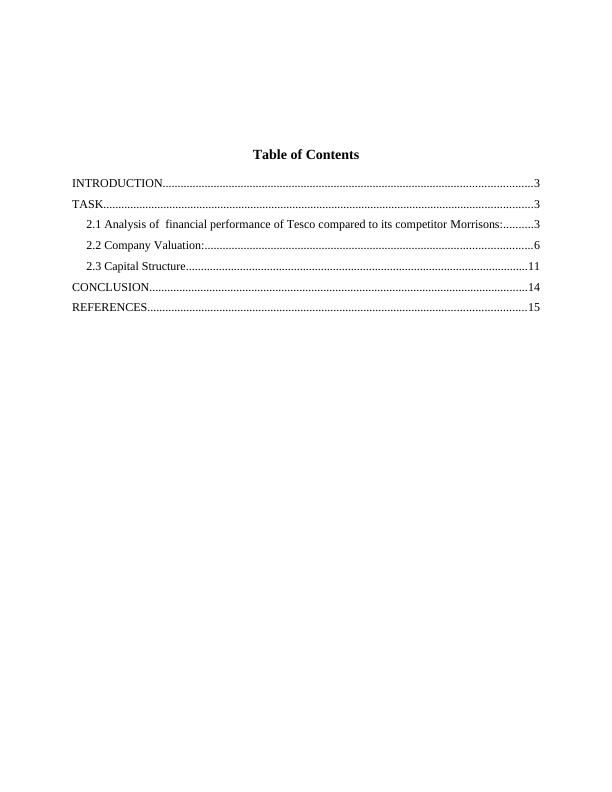
INTRODUCTIONFinance implies studying about money management and figuring the resources needed.The financial world's very basis is Finance. Financial services and financial tools are itselements. Fundamentally, finance is all about acquisition of resources and their perfectoperations management. Capital, resources, cash and monetary figures are a few financialconstructs, but they all have a distinct entity (Weil, Schipper and Francis, 2013). To improvebusiness growth, the principles of finance must be carefully studied and understood. This studycovers financial analysis of Tesco and its competitor, limitations of application of financialanalysis and comparison, and valuation of Tesco from different methods. Study also containscalculation of WACC along with discussion on difficulties in assessing WACC. TASK2.1 Analysis of financial performance of Tesco compared to its competitor Morrisons:A. Analysis of statement of financial position: Analysis of balance sheet can be described as anevaluation of a company's assets, all liabilities and entire equity funds. This analysis is typicallyperformed at fixed time intervals, such as quarterly or annual. The balance sheet evaluationsystem is being used to derive actual data, figures or facts on the business's income, resources,and liabilities (Watty, Jackling and Wilson, 2014). As per analysis of balance sheet of Tesco it has been observed that company's total assetsvalue is 44862 GBP million and liabilities are 34382 GBP Millions in year 2018. WhereasSainsbury has reported total assets of 22001 GBP million and liabilities amounting 14590 GBPmillion in year 2018. Such figures of both companies showing that Tesco is operating at widerscale as comparative of Sainsbury. Tesco's shareholder funds are 10480 GBP million in 2018which is 7411 GBP million in case of Sainsbury. Form above analysis it is clear that Tesco withlarge operating scale and resources giving tuff competition to its competitor Sainsbury.B. Analysis of Income Statements: The income statement analysis encompasses comparison ofvarious line items in a statement and observing trends of individual line products over variousphases. This analysis is often used to comprehend a corporation ' cost structure as well as itscapacity to generate profit. From the analysis of reported income statement of Tesco it has been analysed thatcompany's net profit is 1206 GBP Million while company has earned operating profit of 1564
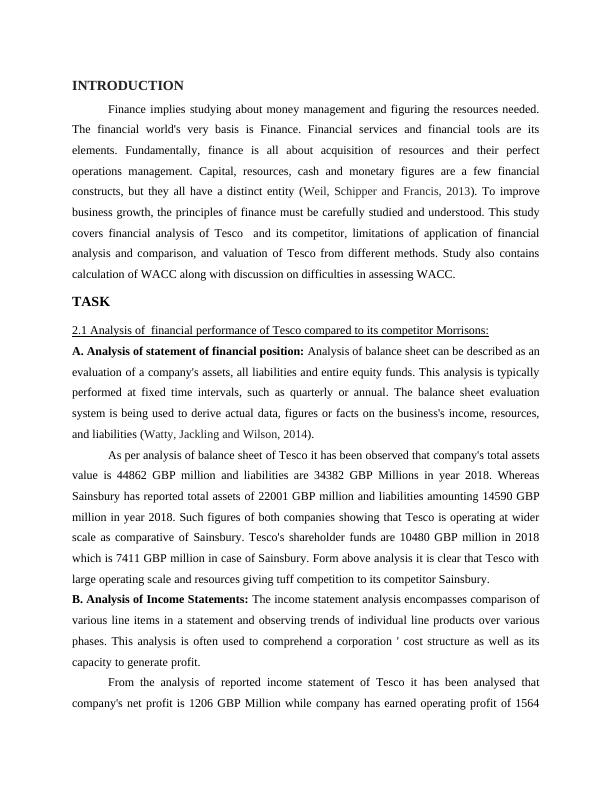
GBP Million in 2018. Whereas Sainsbury has reported net profit of 309 GBP million andoperating profit of 518 GBP million in 2018 (About financial statement of Tesco. 2019). Suchfigures indicates that both companies are able to generate operating and net profits but Tesco asoperating at wide scale so in profitability company is better than it's competitor Sainsbury.C. Ratio Analysis: Ratio analysis is a quantitative approach where a corporation's distinctfinancial ratios, drawn from the fiscal records and other data accessible to the public, areevaluated to obtain insight into financial conditions of the business. Every ratio analysed over aspecific period of time may indicate a deficiency in a company's overall functioning (Tresch,2014). The evaluation could also anticipate a enterprise's future growth-performance in a specificbusiness aspect. In this regard following are important ratios as well as a complete comparativeanalysis of Sainsbury and Tesco plc for year 2018, as follows: Liquidity Ratio: These ratios explains the capacity of one to settle apart his debt as andwhen it is due. Simply these ratios indicates how rapidly a business can transform its totalcurrent assets into liquid funds in order to pay-off its short-term or current obligation on timelymanner (Gitman, Juchau and Flanagan, 2015). Current ratio is one of the major liquidity ratiowhich indicates organisation's efficiencies to pay-off current liabilities applying their current-assets. Following is current ratio of Tesco and competitive firm Sainsbury, as follows:Current Ratio = All Current Assets / All Current LiabilitiesSainsbury PlcTesco PlcCurrent Assets 786613726Current Liabilities1030219238Current Ratio0.760.71Generally current ratio should be at least 2:1, ratio below this is shows that company'sliquidity position is not favourable and require improvement. Here according to above tablecurrent ratio of both companies indicating requirement of improvement in current ratio. Currentratio of Sainsbury is 0.76 which is higher than Tesco's current ratio i.e. 0.71. Indicating thatSainsbury is more efficient to pay-off its current-liabilities by applying current-assets. Tesco'sshould improve their current ratio to avoid any future financial problem.Profitability Ratio: The profitability ratio is being used to assess the capacity of thebusiness to produce revenue in comparison with its expenditures as well as other costs connectedwith revenue generation throughout a given period. Net profit and Operating Margin are two keyprofitability ratios which defines actual profitability position of company over particular time-frame. Here are these ratio in context of Tesco and Sainsbury, as discussed below:
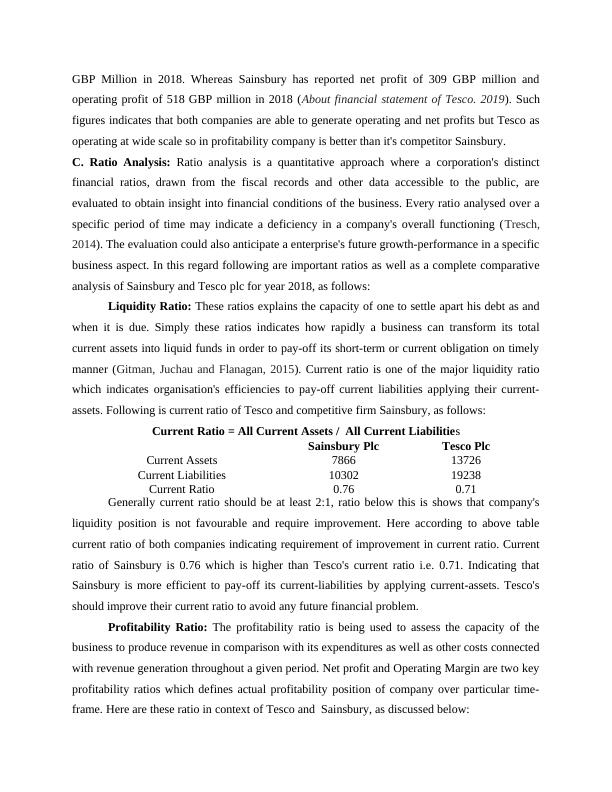
Accounting

TABLE OF CONTENTS
INTRODUCTION ..........................................................................................................................3
MAIN BODY...................................................................................................................................3
1. Analzing the financial performance of TESCO using ratio analysis......................................3
2. Explaining the limitations of accounting ratios while analyzing the company performance. 5
CONCLUSION................................................................................................................................6
REFERENCES................................................................................................................................7
INTRODUCTION ..........................................................................................................................3
MAIN BODY...................................................................................................................................3
1. Analzing the financial performance of TESCO using ratio analysis......................................3
2. Explaining the limitations of accounting ratios while analyzing the company performance. 5
CONCLUSION................................................................................................................................6
REFERENCES................................................................................................................................7
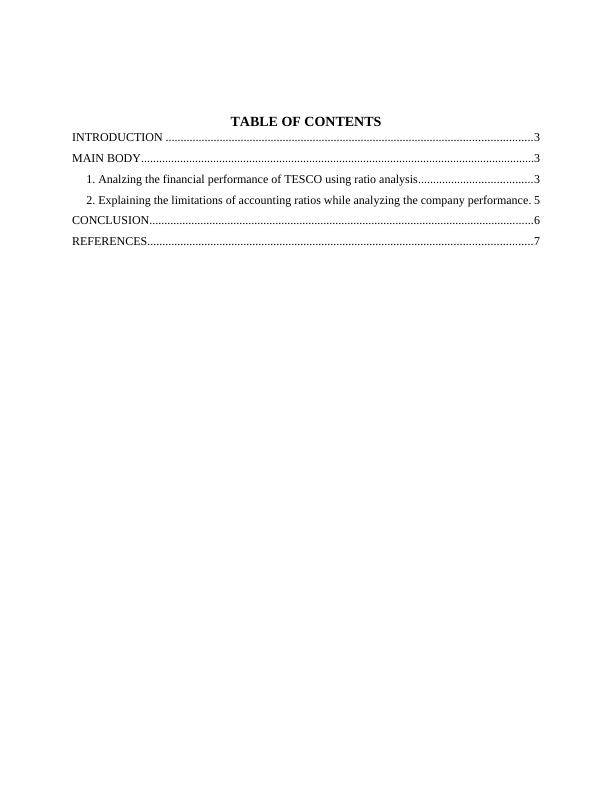
INTRODUCTION
Accounting is the complete procedure of recording and analyzing all the financial
transations that a business undertakes in order to earn profit. It aids the firm in keeping the
expenses within limits and making optimum utlisation of resources. For the purpose of analyzing
and interpreting the financial performance of company, financial ratios are applied. The present
case scenario is based on TESCO Plc which is a british company founded by Jack Cohen in
1919. The company has a retail business of merchandise and groceries headquartered in England.
The present report will analyze and evaluate the complete performance, liquidity and financial
structure of company for a period of 3 years i.e. from 2017 to 2020 with the help of various
accounting ratio and other important information. It will help to explain the company
performance and position in the industry. Further, the report will highlight the limitations of
ratios that arise at the time of evaluating the company.
MAIN BODY
1. Analzing the financial performance of TESCO using ratio analysis
Accounting ratios assesses company performance to compare it with previous year's
performance or with other firms within same industry. Ratios develop the relationship between 2
components of the financial statements to judge the short term and long term financial position.
The complete interpretation of TESCO plc from year 2017 to 2020 is discussed below:
Profitability analysis: The ratios that determine the corporate's ability to secure the
income, equity, assets, all costs, etc. from its regular business activities are Profitability ratios
(Svynarenko, Zhang and Kim, 2019). The organisation is said to have good financial
performance when it yields higher profits and maintain a growth level. To evaluate the TESCO's
profitability, ROCE shows how much income a company generates from each pound of capital
employed. It has suddenly increased from 0.55% to 5.07% from 2017 to 2018 and a gradual
increase from 2018 to 2019 and again declining in 2020 to 3.83%. it shows that company is not
generating enough income from its capital. TESCO can improve the ratio either by enhancing the
revenues or decreasing the overall expenses. Furthermore, Gross margin of company is
increasing from 5.19% to 7.07% from 2017 to 2020. However, net profit shows increase from
0.26% to 2.62% from 2017 to 2019 and a decline to 2.03% in 2020. The huge differenece
between gross and net profit shows that TESCO is incurring a lot of indirect expenses to run its
Accounting is the complete procedure of recording and analyzing all the financial
transations that a business undertakes in order to earn profit. It aids the firm in keeping the
expenses within limits and making optimum utlisation of resources. For the purpose of analyzing
and interpreting the financial performance of company, financial ratios are applied. The present
case scenario is based on TESCO Plc which is a british company founded by Jack Cohen in
1919. The company has a retail business of merchandise and groceries headquartered in England.
The present report will analyze and evaluate the complete performance, liquidity and financial
structure of company for a period of 3 years i.e. from 2017 to 2020 with the help of various
accounting ratio and other important information. It will help to explain the company
performance and position in the industry. Further, the report will highlight the limitations of
ratios that arise at the time of evaluating the company.
MAIN BODY
1. Analzing the financial performance of TESCO using ratio analysis
Accounting ratios assesses company performance to compare it with previous year's
performance or with other firms within same industry. Ratios develop the relationship between 2
components of the financial statements to judge the short term and long term financial position.
The complete interpretation of TESCO plc from year 2017 to 2020 is discussed below:
Profitability analysis: The ratios that determine the corporate's ability to secure the
income, equity, assets, all costs, etc. from its regular business activities are Profitability ratios
(Svynarenko, Zhang and Kim, 2019). The organisation is said to have good financial
performance when it yields higher profits and maintain a growth level. To evaluate the TESCO's
profitability, ROCE shows how much income a company generates from each pound of capital
employed. It has suddenly increased from 0.55% to 5.07% from 2017 to 2018 and a gradual
increase from 2018 to 2019 and again declining in 2020 to 3.83%. it shows that company is not
generating enough income from its capital. TESCO can improve the ratio either by enhancing the
revenues or decreasing the overall expenses. Furthermore, Gross margin of company is
increasing from 5.19% to 7.07% from 2017 to 2020. However, net profit shows increase from
0.26% to 2.62% from 2017 to 2019 and a decline to 2.03% in 2020. The huge differenece
between gross and net profit shows that TESCO is incurring a lot of indirect expenses to run its
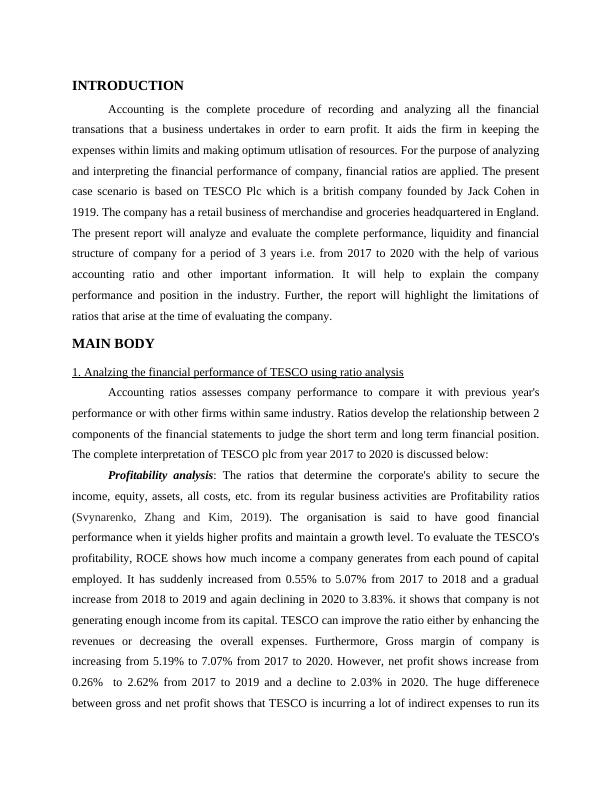
End of preview
Want to access all the pages? Upload your documents or become a member.
Related Documents
Financial Performance of Tesco Analysislg...
|13
|3554
|245
Finance Statement of Tesco Assignmentlg...
|22
|3398
|138
Financial Analysis : The Tesco Companylg...
|21
|3429
|37
Comparative Analysis of Financial Statement and Ratio Analysis of Tesco and Sainsburylg...
|13
|1784
|86
Financial Analysis of Tesco Plc and Valuation Methodslg...
|14
|2630
|3
Report on Financial Capacity of Tesco and Sainsberylg...
|17
|1447
|113
